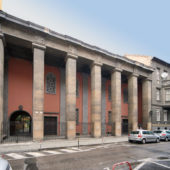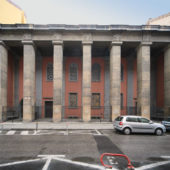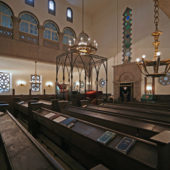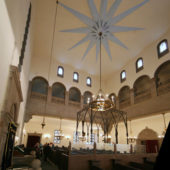The Bratislava synagogue’s colonaded exterior is in stark contrast to the soft colors and moorish style interior.
The first documentation of Jews in Bratislava is in 1251. The presence of Jews in the city was regulated by the municipal charter King Andrew III Arpád granted the city in 1291. This charter included laws stating that Jews were allowed to live within the city walls, they had the privilege of electing their own mayor and were to pay taxes directly to this elected mayor. Bratislava’s first synagogue was built in 1335. Unfortunately, the Jewish community was expelled from Bratislava several times thereafter, the last time being in 1526. In 1599, the community subsequently returned to a narrow portion of land outside of the city walls between the castle and town walls, as per invitation by Count Pálffy. The Jewish community lived this area, known as the Judangesse, until 1840.
There was a period when Bratislava was considered to be the heart of European Judaism. It is from here that Jewish culture spread to the rest of the world, prior to World War II. Pilgrims from all over the world come to visit the Chatam Sofer Mausoleum of Bratislava. Chatam Sofer, a gifted child, was born on September 24, 1762 in Frankfurt am Main. Beginning school at three years of age, he knew the Talmud by age seven, and by ten years old he publicly discussed and refuted experts on Talmudic subjects. After finishing Hebrew, Talmud and Torah schooling, he became a well-known and respected itinerant teacher, held in highest esteem for his wisdom and knowledge. He eventually chose to be the Rabbi of Bratislava in 1806, because it was a sophisticated city at that time and he remained in that position 33 years, until his death. He became the leader of the Jewish school, which had 120 students. It is because of Rabbi Sofer that his Synagogue, which had been founded in the 13th century, became the foremost seat for Jewish learning in the 19th century.
At the beginning of World War II, the Jewish school closed down in Bratislava; however, it moved to Israel and was named Pressburger Synagogue. Interestingly, the most profound rabbis in the 19th century came from Slovakia, whether they initially were from New York, London, Vienna, Hungary, Frankfurt, Berlin, Budapest, Great Britain or its Empire. Rabbi Sofer is esteemed as the founder of Orthodox Judaism. He died in Bratislava on October 3, 1839.
Initially, Bratislava Synagogue was built as a Reform Synagogue, designed by architect Dezslo Milch, constructed from 1893 to 1895. But by 1927, due to the influence of Rabbi Sofer, there was a much greater need, for both Orthodox and Reform facilities. Architect Artur Szalatnai-Slatinsky designed a ‘synagogue complex’ comprising eleven synagogues, six prayer houses, six schools (including Rabbi Sofer’s famous Yeshiva), eleven Orthodox houses of study, and two schools for the Reform community. Most of the complex was destroyed after World War II by the Communists; what has remained is a monumental edifice boasting a stark exterior colonnade with seven columns.
The interior is unusual, with a marriage of innovative concrete-steel construction and period cubist details, in combination with historical elements such as the arcade row in the women’s gallery.
Interestingly, stone is used decoratively in ceiling, wall and window moldings; and beautifully decorated with Moorish motifs and square columns to support arched walls in the upstairs balcony, which is situated against the back and side walls. A massive starburst protrudes from the ceiling just above the steel “canopy,” built up from the steel balustrade, encompassing the tivah (reader’s desk), located in the center of the prayer room. A large chandelier drops down from the center of the starburst. The Aron-Kodesh is also finely wrought from stone, sitting on a platform a few steps up, with stone balustrades flanking the steps. A beautiful and usually shaped vertical stained-glass window sits above the Aron-Kodesh. Round windows with stone moldings adorn the wall on either side of the bimah. Wooden pews fill the sanctuary.
The Synagogue complex survived the World Wars, but was destroyed by the Communists in order to build a highway in 1961 and the Reform Synagogue was destroyed in 1967 to build a bridge. However, most Bratislava Jews were not as fortunate and were killed in the Holocaust. Today, there are approximately 1,000 Jews in Bratislava. A small, active community comprised largely of elderly people, worship at Bratislava Synagogue. Their spiritual leader is an American Rabbi, Baruch Myers. They meet weekly to observe Shabbat and also to celebrate the High Holidays.
Bratislava has been a foundational city in terms of affecting Jewery around the rest of the world and it is in fact, the home of Orthodox Judaism. Its proud history will not be forgotten and the synagogue at Bratislava is still serving its active community there.





